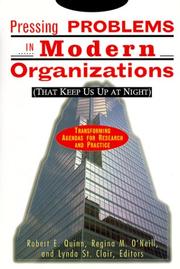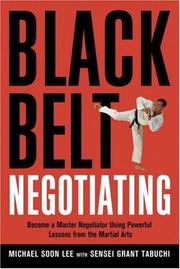| Listing 1 - 10 of 491 | << page >> |
Sort by
|
Periodical
ISSN: 23767197 21516561 Year: 1938 Publisher: [St. Louis, etc.] : Academy of Management.
Abstract | Keywords | Export | Availability | Bookmark
 Loading...
Loading...Choose an application
- Reference Manager
- EndNote
- RefWorks (Direct export to RefWorks)
Academy of Management Annual Meeting Proceedings includes abstracts of all papers and symposia presented at the annual conference. 6-page abridged versions of the “Best Papers” accepted for inclusion in the program (approximately 10%) are also published (abridged because presenting papers at their full length could preclude subsequent journal publication). Readers may be able to contact the author(s) directly to request a copy of the full papers.
Industrial management --- Industrial management. --- Management. --- Business administration --- Business enterprises --- Corporate management --- Corporations --- Industrial administration --- Management, Industrial --- Rationalization of industry --- Scientific management --- Management --- Business --- Industrial organization
Book
ISBN: 0128189371 0128183640 9780128189375 9780128183649 Year: 2019 Publisher: Oxford, United Kingdom : Butterworth-Heinemann, an imprint of Elsevier,
Abstract | Keywords | Export | Availability | Bookmark
 Loading...
Loading...Choose an application
- Reference Manager
- EndNote
- RefWorks (Direct export to RefWorks)
Production Planning and Control draws on practitioner experiences on the shop floor, covering everything a manufacturing or industrial engineer needs to know on the topic. It provides basic knowledge on production functions that are essential for the effective use of PP&C techniques and tools. It is written in an approachable style, thus making it ideal for readers with limited knowledge of production planning. Comprehensive coverage includes quality management, lean management, factory planning, and how they relate to PP&C. End of chapter questions help readers ensure they have grasped the most important concepts. With its focus on actionable knowledge and broad coverage of essential reference material, this is the ideal PP&C resource to accompany work, research or study. Uses practical examples from the industry to clearly illustrate the concepts presented. Provides a basic overview of statistics to accompany the introduction to forecasting. Covers the relevance of PP&C to key emerging themes in manufacturing technology, including the Industrial Internet of Things and Industry.
Industrial management. --- Business administration --- Business enterprises --- Business management --- Corporate management --- Corporations --- Industrial administration --- Management, Industrial --- Rationalization of industry --- Scientific management --- Management --- Business --- Industrial organization
Periodical
ISSN: 2407263X 24072648 Year: 2014 Publisher: Medan, Indonesia : Management Study Program, Faculty of Economics and Business, University of Medan Area,
Abstract | Keywords | Export | Availability | Bookmark
 Loading...
Loading...Choose an application
- Reference Manager
- EndNote
- RefWorks (Direct export to RefWorks)
Industrial management --- Industrial management. --- Business administration --- Business enterprises --- Corporate management --- Corporations --- Industrial administration --- Management, Industrial --- Rationalization of industry --- Scientific management --- Management --- Business --- Industrial organization
Periodical
ISSN: 26552523 20890176 Year: 2011 Publisher: Malang, Indonesia : Program Studi Manajemen, Fakultas Ekonomi dan Bisnis, Universitas Muhammadiyah Malang,
Abstract | Keywords | Export | Availability | Bookmark
 Loading...
Loading...Choose an application
- Reference Manager
- EndNote
- RefWorks (Direct export to RefWorks)
Industrial management --- Industrial management. --- Business administration --- Business enterprises --- Corporate management --- Corporations --- Industrial administration --- Management, Industrial --- Rationalization of industry --- Scientific management --- Management --- Business --- Industrial organization
Book
ISBN: 2759812936 2759811859 9782759812936 9782759811854 Year: 2014 Publisher: Ulis, France : EDP Sciences,
Abstract | Keywords | Export | Availability | Bookmark
 Loading...
Loading...Choose an application
- Reference Manager
- EndNote
- RefWorks (Direct export to RefWorks)
Cet ouvrage aborde les Facteurs Humains et Organisationnels (FHO) qui s’invitent lors des différentes phases de la vie (de la conception au démantèlement) d’une installation à risques. Les organisations à risques sont avant tout des systèmes humains. Derrière cette entrée en matière quelque peu provocatrice au sein d’univers techniques se cache l’ambition de mettre en lumière les mécanismes individuels et collectifs qui façonnent ce type d’organisation. Sur quels ressorts reposent les comportements à risques ? Pourquoi certains groupes sont-ils incapables de se coordonner ? Pourquoi les organisations répètent-elles leurs erreurs ? Ces quelques exemples de questions sont de toute évidence au centre des enjeux de sûreté et de sa gestion. Pourtant, si les Facteurs Humains et Organisationnels font désormais partie du vocabulaire commun des praticiens de la sûreté, ils sont encore trop fréquemment assimilés à la notion, trop restrictive, d’erreur humaine. Considérant au contraire qu’une défaillance humaine ne peut se comprendre sur le même mode qu’une défaillance technique, cet ouvrage proposera un parcours d’exploration de la dimension humaine de la sûreté. Comme le montreront les analyses d’accidents relatés au fil des chapitres, les barrières techniques n’atteignent leur pleine efficacité que si elles sont comprises, appropriées et utilisées par les opérateurs : les systèmes techniques et sociaux sont indissociablement liés.
Industrial management. --- Business administration --- Business enterprises --- Business management --- Corporate management --- Corporations --- Industrial administration --- Management, Industrial --- Rationalization of industry --- Scientific management --- Management --- Business --- Industrial organization

ISBN: 058511451X 9780585114514 0814470521 Year: 2000 Publisher: New York : American Management Association,
Abstract | Keywords | Export | Availability | Bookmark
 Loading...
Loading...Choose an application
- Reference Manager
- EndNote
- RefWorks (Direct export to RefWorks)
"In Pressing Problems in Modern Organizations, professors and researchers of the University of Michigan's Graduate School of Management explore the most complex dilemmas in business - and seek solutions to them." "Taking their cue from a direct survey of managers at 117 companies, the contributors to this book show you realistic ways to understand, investigate, and solve these "pressing problems." We hear both managers' and researchers' perspectives about what "keeps them up at night." Next, the contributors draw upon their expertise in the theory of organizational behavior to expand this detailed interview data into useful insights and grounded information. Pressing Problems in Modern Organizations shows how current knowledge in the field can help you reach goals." "You'll find a carefully constructed, easy-to-implement structural framework designed to bring new problems in the organization immediately to the surface, so they can be dealt with before they do any damage."--BOOK JACKET.
Industrial management. --- Business administration --- Business enterprises --- Business management --- Corporate management --- Corporations --- Industrial administration --- Management, Industrial --- Rationalization of industry --- Scientific management --- Management --- Business --- Industrial organization

ISBN: 1621983676 1281128090 9786611128098 0814400752 9780814400753 9781621983675 0814474616 9780814474617 9781281128096 Year: 2007 Publisher: New York : American Management Association,
Abstract | Keywords | Export | Availability | Bookmark
 Loading...
Loading...Choose an application
- Reference Manager
- EndNote
- RefWorks (Direct export to RefWorks)
The best martial artists know what they want when they enter the arena, they know how to get it, and they're not afraid to go after it. The same could be said of great negotiators. This book uses the principles of martial arts to guide readers step-by-step, from basic techniques through advanced strategies, all the way to achieving their "black belt" in negotiating. Packed with quizzes, scripts, checklists, and even a Negotiating Rating Sheet for continual self-assessment, the book trains readers in martial arts–based negotiation fundamentals, including: * Don’t Fear the Blow -- Black belts aren't afraid of being hit or they would never step onto the mat. Get over your fear of bargaining, and the fight is already won. * Identify Vital Striking Points -- Weaken others' positions by identifying what's most important to them...and bring down even the biggest opponent. * Read Your Opponent -- Counter an opponent’s moves by honing in on what technique they’re using -- and hit them with the perfect response. Grounded in authentic martial arts tactics, this book turns novice bargainers into black belt negotiators who can get whatever they want out of any situation.
Negotiation in business. --- Industrial management. --- Business administration --- Business enterprises --- Business management --- Corporate management --- Corporations --- Industrial administration --- Management, Industrial --- Rationalization of industry --- Scientific management --- Management --- Business --- Industrial organization
Book
ISBN: 3486719866 9783486719864 Year: 2013 Publisher: Berlin ; Boston : Oldenbourg Wissenschaftsverlag,
Abstract | Keywords | Export | Availability | Bookmark
 Loading...
Loading...Choose an application
- Reference Manager
- EndNote
- RefWorks (Direct export to RefWorks)
Innovationen entstehen nicht zufällig, sondern absichtlich. Speziell für Wirtschaftsingenieure stellt sich eine Innovation als Ergebnis von Managementprozessen dar, welche auf zielorientierter Projektarbeit, Marketing und einem wissenschaftlichen Vorgehen beruhen. Dieses neuartige Lehr- und Arbeitsbuch zum Thema Innovationsmanagement erklärt die verschiedenen Begriffe, gibt Erläuterungen anhand von Beispielen und fasst die verschiedenen Lektionen in einfachen Lehrsätzen zusammen. Das Konzept ist insbesondere geeignet für modularisierte Studiengänge an Universitäten und Fachhochschulen. Zunächst trifft der Autor eine Unterscheidung zwischen den ökonomischen, evolutionären, revolutionären und technologischen Aspekten von Innovationen. Anschließend arbeitet er für Innovationsprojekte die besonderen Erfolgsfaktoren, die Innovationsphasen, die Promotoren und die Innovationskultur heraus. Beim Thema Innovationsmarketing wird auf Marktzyklen, -barrieren, Design und Open Innovation eingegangen. Erstmals werden in diesem Buch auch die wissenschaftlichen und kreativen Prozesse strukturiert. Als "Scientific Innovation" wird die Ideengeschichte, das Erzeugen, Entfalten, Bestätigen und Erfassen von innovativem Wissen eingeführt. Und Erfindungen werden funktional unterteilt als Folge von Problemlösungen, Forschung, Prognosen oder purer Fantasie.
Industrial management. --- Industrial engineers. --- Engineers --- Business administration --- Business enterprises --- Business management --- Corporate management --- Corporations --- Industrial administration --- Management, Industrial --- Rationalization of industry --- Scientific management --- Management --- Business --- Industrial organization
Book
ISBN: 1536107395 9781536107395 9781536107388 Year: 2017 Publisher: New York : Nova Publishers,
Abstract | Keywords | Export | Availability | Bookmark
 Loading...
Loading...Choose an application
- Reference Manager
- EndNote
- RefWorks (Direct export to RefWorks)
Industrial management. --- Business administration --- Business enterprises --- Business management --- Corporate management --- Corporations --- Industrial administration --- Management, Industrial --- Rationalization of industry --- Scientific management --- Management --- Business --- Industrial organization
Book
ISBN: 1681236400 9781681236407 1681236397 9781681236391 9781681236384 Year: 2017 Publisher: Charlotte, NC : Information Age Publishing, Incorporated,
Abstract | Keywords | Export | Availability | Bookmark
 Loading...
Loading...Choose an application
- Reference Manager
- EndNote
- RefWorks (Direct export to RefWorks)
Industrial management. --- Business administration --- Business enterprises --- Business management --- Corporate management --- Corporations --- Industrial administration --- Management, Industrial --- Rationalization of industry --- Scientific management --- Management --- Business --- Industrial organization --- Industrial management --- E-books
| Listing 1 - 10 of 491 | << page >> |
Sort by
|

 Search
Search Feedback
Feedback About UniCat
About UniCat  Help
Help News
News